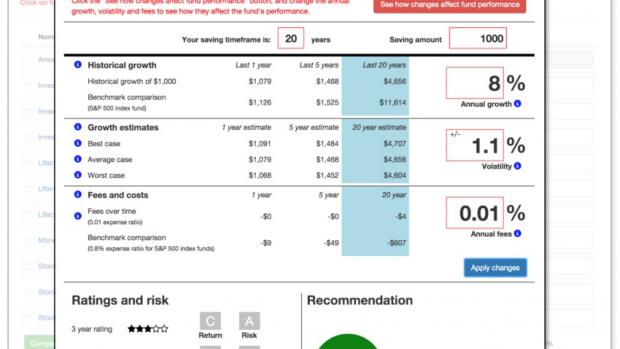Interactive “Nutrition Label” for Financial Products Simplifies Retirement Funds, Helps Investors Make Better Choices
NYU Tandon Researchers Introduce Interactive Design for Financial Products, Helping Novices and Experts Alike Make Smarter Investment Choices

Every day millions of people mulling their retirement plan saving choices go online to study the offerings at retirement fund websites. Research shows, however, that they often choose high fee options, underinvest or don’t invest at all because they don’t understand the performance estimates, risks, recommendations, fee structures, and other disclosures that funds provide.
To address this issue, Junius Gunaratne, a doctoral student, and Oded Nov, an associate professor in the Department of Technology Management and Innovation at the NYU Tandon School of Engineering, created the first online, interactive “nutrition label” for financial products that, like the ubiquitous information nutrition panels on food and packaged goods, is simple, easy to read and uncluttered. What’s more, the financial label is interactive, allowing people to easily get a sense of the long-term implications of choices they make today.
Their first tests revealed that non-expert investors significantly improved their ability to reach simulated retirement savings goals. The study also revealed that novices who invested using the interactive labels were far more likely to invest in low-fee funds — a strategy that is widely advised because of the potentially large positive effects of compound interest. Nov and Gunaratne tested variants of their interactive financial labels with 450 test subjects in a retirement simulation experiment, in which the subjects were given $10,000 per simulation year and asked to save $1.5 million over 35 years, distributed among 10 stock, bond, and cash funds.
The participant pool was divided into four groups: those who received “nutrition label” fund information pages requiring interactivity; those who received the same information in static form; those who received pages in which interactivity was optional; and a control group who received financial information in a format currently used by leading investment firms.
“The impetus for taking the nutrition label approach is the need to help people make sense quickly and effortlessly, taking into account future implications of possible actions they make now,” said Gunaratne.
“Unlike food labeling, however, we added the ability to check out different choices and their impacts. Interactivity enabled users to learn about the attributes of funds much like repeated decision-making over time helps people better understand risk and reward,” said Nov. The information label borrows layout, print size, organization, justification, typography, information design and line spacing from nutritional labels.
Gunaratne and Nov found that interactivity increased understanding and improved decision-making. Those who used the interactive version of the financial nutrition labels (whether by choice or because of the researchers’ requirement) were 54% more likely to reach their goal than those in the control group.
“Our motivation is really to build something that is easy for people to understand — that they can engage with and make personal so they can achieve long-term benefits,” said Nov. “This is critical because research has shown that consumers don’t save in effective ways, and leave a lot of money on the table.”
Gunaratne added that individual investors are paying too much and getting too little, “Which is why the U.S. has a serious problem of underfunded retirement accounts — most Americans will take serious financial hits and see reduced standards of living when retiring because they don’t save effectively, due to uninformed decisions.”
The findings hold policy implications: “As demonstrated in our research, interactive financial product information labels can help consumers make better and more informed decisions,” the authors wrote. “Regulators should therefore consider mandating the use of interactive information labels for financial products, just as simpler labels are used in other contexts such as food and other consumer products.”
“Using Interactive 'Nutrition Labels' for Financial Products to Assist Decision Making Under Uncertainty,” was recently accepted for publication in the Journal of the Association for Information Science and Technology.
A draft version is available at http://faculty.poly.edu/~onov/Gunaratne_Nov_JASIST_final.pdf.
Note: Images available at http://dam.poly.edu/?c=1872&k=1b42689144
About the NYU Tandon School of Engineering
The NYU Tandon School of Engineering dates to 1854, when the New York University School of Civil Engineering and Architecture as well as the Brooklyn Collegiate and Polytechnic Institute (widely known as Brooklyn Poly) were founded. Their successor institutions merged in January 2014 to create a comprehensive school of education and research in engineering and applied sciences, rooted in a tradition of invention, and entrepreneurship and dedicated to furthering technology in service to society. In addition to its main location in Brooklyn, NYU Tandon collaborates with other schools within the country’s largest private research university and is closely connected to engineering programs in NYU Abu Dhabi and NYU Shanghai. It operates business incubators in downtown Manhattan and Brooklyn and an award-winning online graduate program.




